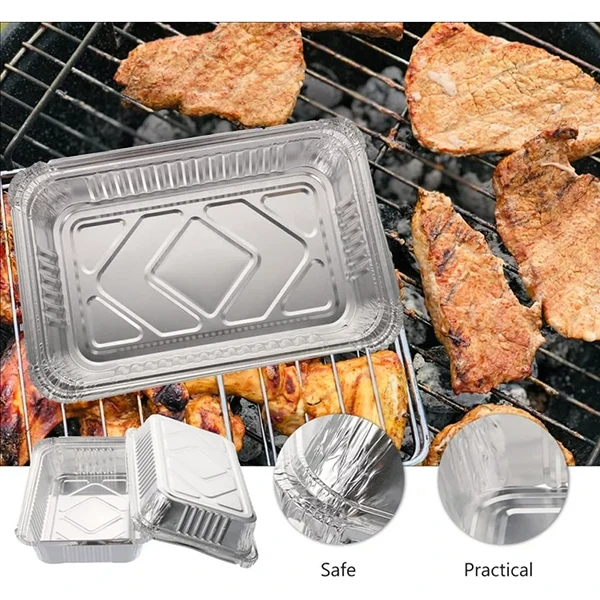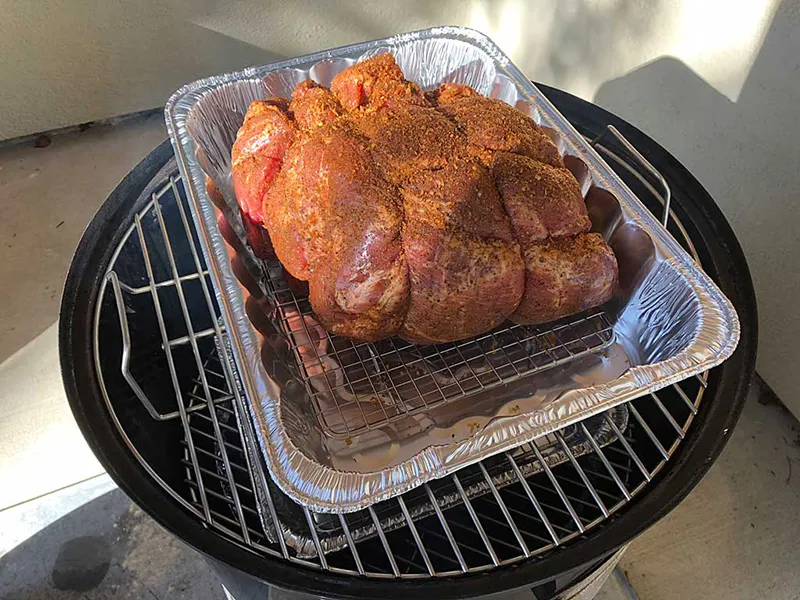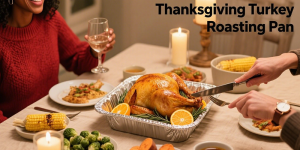
Grilling is a beloved cooking method that can be adapted to suit different tastes and preferences. People can add various seasonings according to personal preferences, making it a social activity for family gatherings, friends’ dinners, and company gatherings.
Traditional barbecue needs equipment like a grill, charcoal fire, or oven. However, an aluminum foil baking pan can go directly in the oven or grill. It can also hold fat and juice well.
Aluminum foil has good thermal conductivity and can transfer heat evenly without causing food to burn. This article will introduce you to grilling meat in a foil grill pan:
What Is Foil Roasting Pan
A foil roasting pan is a type of cookware made for roasting. It is mainly used for large cuts of meat, like a Thanksgiving turkey or a Christmas glazed ham. The most common model is a rectangular, 12 x10 x4 deep foil roaster pan.
On the market, you can also find oval roaster pans, roaster pans with holes, round roaster pans, etc.
Barbecue Steps
Choose Foil Grill Pan
Depending on how you roast the meat, prepare some roasting foil pans. Rectangular or oval pans are ideal for holding large pieces of meat. The thicker the foil grill pan, the less likely it is to deform and the greater the heat it can withstand.
If serving large roasts, it’s best to choose a plate with reinforced edges or handles. The following are common aluminum foil roaster pan sizes for reference:
| Name | Size | Depth | Capacity | Thickness | Weight | Packing |
| YSA-B525A | Top out: 525x328mm Top in: 495x300mm Bottom: 440x245mm | 76mm | 9700ml | 0.147mm | 100g | 50pcs |
| YSA-B525B | Top out: 525x326mm Top in: 508x308mm Bottom: 473x277mm | 42mm | 5360ml | 0.135mm | 87g | 50pcs |
| YSA-B466 | Top out: 466x268mm Bottom: 354x352mm | 80mm | 6885ml | 0.12mm | 66g | 50pcs |
| YSA-T455 | Top out: 455x360mm Top in: 410x330mm Bottom: 354x280mm | 85mm | 7585ml | 0.116mm | 75g | 50pcs |
| YSA-T470 | Top out: 470x345mm Top in: 436x326mm Bottom: 380x268mm | 84mm | 6800ml | 0.127mm | 76g | 50pcs |
| YSA-B430 | Top out: 430x310mm Top in: 395x275mm Bottom: 355x240mm | 65mm | 5830ml | 0.11mm | 70g | 50pcs |
| YSA-P345 | Top out: 345x246mm Top in: 320x234mm Bottom: 250x137mm | 21mm | 990ml | 0.115mm | 22g | 200pcs |
| YSA-P545 | Top out: 545x362mm Top in: 513x333mm Bottom: 400x218mm | 21mm | 2270ml | 0.15mm | 65g | 50pcs |
Prepare Grill
Start by scrubbing the grill grates to remove debris and residue. Preheat grill to desired temperature. You can place a heatproof mat or foil on the grill rack and then place the baking sheet on top.
Prepare Meat
Choose cuts suitable for grilling, such as steaks, burgers, chicken nuggets or pork chops. Thinner cuts of meat can be grilled directly, while thicker cuts require indirect grilling.
By using marinades or spices, the meat is covered and placed in the refrigerator. It should stay there for the recommended time to let the flavors soak in.
Prepare Foil Roaster Pan
Line the bottom of the roasting pan with aluminum foil paper, extending it to the edges. The foil lining will prevent the meat juices from sticking to the pan.
For foods that you want to cook slowly, use a double layer of aluminum foil sheet to create a drip tray. Shape the foil into a shallow tray and place it in the center of the baking sheet to catch drippings and prevent burning.
For some cuts of meat that are difficult to cook, you can place a wire rack or grill inside the aluminum foil baking pan. This will prevent the meat from directly penetrating into the juice and make it easier to heat evenly.

Preheat Grill Pan
Place an empty aluminum foil baking pan on the preheated grill. Preheating the pan will heat it to the right temperature. This helps sear the food better and reduces sticking.
When the meat comes into contact with the preheated pan, it forms a seared crust that locks in natural juices and flavor. The preheated pan also helps prevent meat from sticking to the surface, making it easier to flip and remove.
BBQ Tips
- Thin meat: Put the meat on the hot baking sheet. Spread the pieces out. Flip them with tongs or a spatula. Keep an eye on the time.
- Thick meat: Put the meat on the rack of a roasting pan, ideally in the center. Place a foil baking sheet on the rack. Larger pieces of meat, like roasts or whole chickens, may need more cooking time before serving.

Oiled and Scented
- Brush the meat with marinade or sauce while grilling, and basting it with oil will add moisture and enhance flavor. If you like a smoky flavor, soak wood chips in water and place them in a smoke box made of aluminum foil. Place the wrap directly on the heat source of the grill to release the smoke and give the meat a smoky flavor.
- Various seasonings, such as rosemary, thyme, paprika, cumin or paprika, can be added.
Things to Note
- Pay close attention to the grill temperature during the entire cooking process, and adjust the heat source or grill vent in time. The temperature should not be too high or too low.
- Don’t let fat or marinade drip onto the grill’s heat source, as this could start a fire. Keep the meat away from the flame when using long-handled tongs.
Enjoy Barbecue
Allowing the roast to rest before serving ensures maximum juiciness and tenderness. Using tongs or a spatula, carefully remove the cooked meat from the foil baking dish. Transfer the meat to a clean cutting board and let rest for a few minutes to allow the juices to redistribute. This step is especially important with larger cuts of meat, as it allows the muscle fibers to relax and retain moisture.
When serving, slice the roast against the grain, which shortens the muscle fibers and makes the texture more tender and easier to chew. If desired, you can garnish with fresh herbs and serve with your side dish or sauce.
After Use Treatment
Allow the foil-lined baking sheet to cool completely before carefully removing and disposing of the used foil. If the foil baking pan is reusable, wash it with warm soapy water and a soft sponge.
Once the grill has cooled, remove the heatproof mat or foil from the grill. Use a grill brush to scrub the grates to remove any remaining debris.



